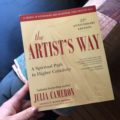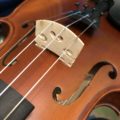Book of the week: The Sound of Paper
Julia Cameron’s The Sound of Paper: Starting From Scratch is a sort of companion book to her bestseller The Artist’s Way.
The book unfurls over the course of one of Cameron’s annual journeys to her then-summer home of Taos, New Mexico from her then-usual home of Manhattan. Cameron and her assistant Emma would go to Taos as a long writer’s retreat to work on their musical projects as well as Cameron’s books.
The basic structure is dozens of short essays (2-4 pages each), each followed by an exercise related to writing in some way. The essays weave descriptions of the changing season and weather and other elements of the natural world with discussion of psychological issues writers and other artists may face, everything from imposter syndrome to dealing with brutal inner critics and fan adulation.
A major theme of The Sound of Paper is drought, both the natural one Taos was in the midst of during the writing of the book and the creative sort all artists go through at one time or another. There are also essays talking about the opposite, when one needs to cope with too many projects or feeling like one can’t keep up with the flow of ideas for a given project.
Exercises tend to examine small but practical and manageable steps that a blocked artist can take to move forward in his career or on his project. They also encompass a wide range of brainstorming to open up other possible angles of attack or exploration, with topics like things you’d love to try, ways to reward yourself, imaginary lives you would like to have, unnecessary drama in your daily life, and reverse-engineering how much you need to write/paint/work each day to finish a given project in how many months from now.
As in Cameron’s other books, her emphasis is on proper self-care and self-talk, and setting a daily routine of manageable workloads that add up over time.
Throughout the whole book, Cameron’s love of the Southwest’s rugged landscape shines through, along with her noticing how the rhythms of her natural surroundings match up with the rhythms of her working life. The more an artist tunes into those rhythms, the more they will realize the cycles they go through and—hopefully!—the less they will catastrophize if they feel blocked. In other words, this too will pass.
I’ve been reading this one on and off since last summer, and while I’m not really dealing with any major blocks these days, I certainly have some procrastination on some projects. And like Cameron’s other works, I’ve found The Sound of Paper quite helpful with little tricks to keep chugging away at my various projects. I’ve also thoroughly enjoyed the description of spring yielding to summer and then to the start of fall in Taos.



